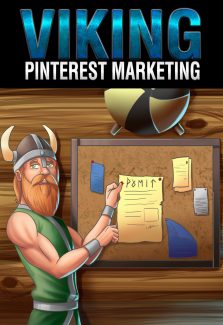
 License Type: Private Label Rights
License Type: Private Label Rights  File Type: ZIP
File Type: ZIP
 SKU: 61834
SKU: 61834  Shipping: Online Download
Shipping: Online Download
Sample Content Preview
Chapter 1: Introduction
Why You Should Market Your Business on Pinterest
There are so many social media platforms to choose from, that most business owners focus their time and attention on one or two. When deciding which sites are the best to brand and market your business, you must not forget the visually engaging Pins and Boards found on Pinterest.
There are a few standout ways in which Pinterest varies from other social media sites. While you can “follow” users, and they can “follow” you—it’s not about friends and followers.
Instead, it is about generating instant access to engaging visual imagery and informative Pins regarding any and every area of interest. These Pins can then be added to a user’s personal boards for future reference. Anyone can access any other users Pins by the category or keywords related to the Pin. While each Pin can have a bit of text or even a URL, the goal is not the “here’s where I am or what I’m doing” topic of most social media platforms. Instead, a relevant comment regarding the post, and what it represents is standard. Most importantly, unlike Facebook and Twitter where your posts peak engagement is rarely more than 5 days (or a few hours) Pins can continue to show up in search results indefinitely.
Still Not Convinced, Check Out These Statistics
If you're inclined to stick with the major players, like Facebook and Twitter, don’t write off Pinterest until you take a closer look at the statistics. First off, let’s talk about the shear size of your potential audience. Pinterest boasts an insane 150 million active users. Yeah, you heard that right. 70 million of those are in the US, with 80 million outside the US. As can be expected, Pinterest activity is proportionately astronomical. There are over 75 billion Pins, which have been posted to over 1 billion public and private user boards. Over 2 billion shopping pins are posted daily. 87% of users make purchases after seeing products or services on Pinterest and 93% use it with an eventual purchase (online or offline) as their primary goal, which makes Pinterest a no-brainer platform for those seeking to sell goods and services to a shopping-minded audience. And 72% of users make offline purchasing decisions based on Pinterest content. So it’s not just a goldmine for online businesses.
The average Pinterest user session is just over 14 minutes, which is very impressive when you compare that to most other social media platforms. 14 million rich pin articles are posted every day and a whopping 5% of all web traffic comes from Pinterest. 80% of Pinterest users access the site from a mobile device, so mobile marketing and mobile-friendly content is very important here, and 2 out of 3 pins are posted by businesses or brands, so you’ve got some competition. Oh, and if you happen to be in the culinary niche, guess what: there are over 1.7 billion recipes on Pinterest.
As for your audience make-up, 81 percent of Pinterest users are women, so the “Pinterest is for girls” stereotype clearly has some truth to it, at least from a market research perspective. But don’t worry, if your target audience is males, the percentage of men on the site is increasing rapidly, making up about 40% of new users recently. In case you were wondering, the most popular categories for these new male Pinterest users are technology, food and drink (big surprise, right?). As for age, millennials are using Pinterest just as much as Instagram. The median age of users is 40 years old, but the most active “pinners” are under the age of 40.
So, now that we’ve established why you should definitely be marketing on Pinterest, let’s talk about some Pinterest goals.
Chapter 2:
Pinterest Marketing Goals
Establishing marketing goals is critical to the success of your Pinterest marketing. Countless entrepreneurs and businesses have setup a Pinterest presence, made a few posts, and then let it sit untouched for months or even years. This is usually due to a lack or absence of goals. So, before you even begin establishing any sort of Pinterest presence or strategy, you need to establish clear marketing goals.
Your goals should be specific, measurable, and attainable. They can be long term, short term, or a mix of both. Deadlines and milestones can be helpful as well. “I want to increase my social following” would be an example of a bad goal that will likely result in your marketing efforts petering out after a while because there are no specific milestones. “I want to gain 1,000 likes by Christmas” is an example of a good goal. It’s specific, measurable, and certainly attainable. Below are some examples of the various goal categories you might be interested in.
Traffic to Website (Sales, Leads, Content)
Probably one of the most popular goals of Pinterest Marketing is to funnel your Pinterest traffic back to your own web properties. After all, most businesses don’t do business “on” Pinterest. You’re leveraging Pinterest to obtain traffic and convert that Pinterest traffic into brand-followers, leads, prospects, and customers. So maybe your goal is to get people to a landing page with a free offer where they can subscribe to your list and become a lead. Maybe they’re being sent to a sales page or an eCommerce store. Maybe you just want to do some content marketing and send them to your blog. Whatever the case, the end goal for a lot of businesses will likely be bringing Pinterest traffic AWAY from Pinterest and over to their own web properties.







